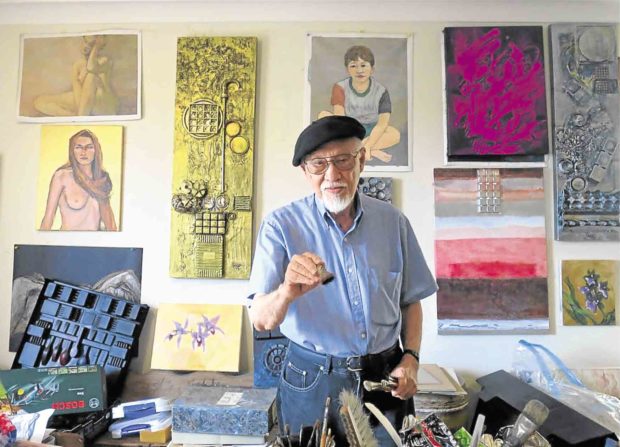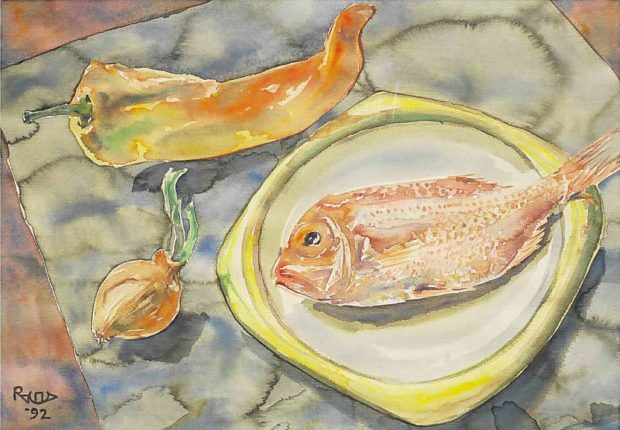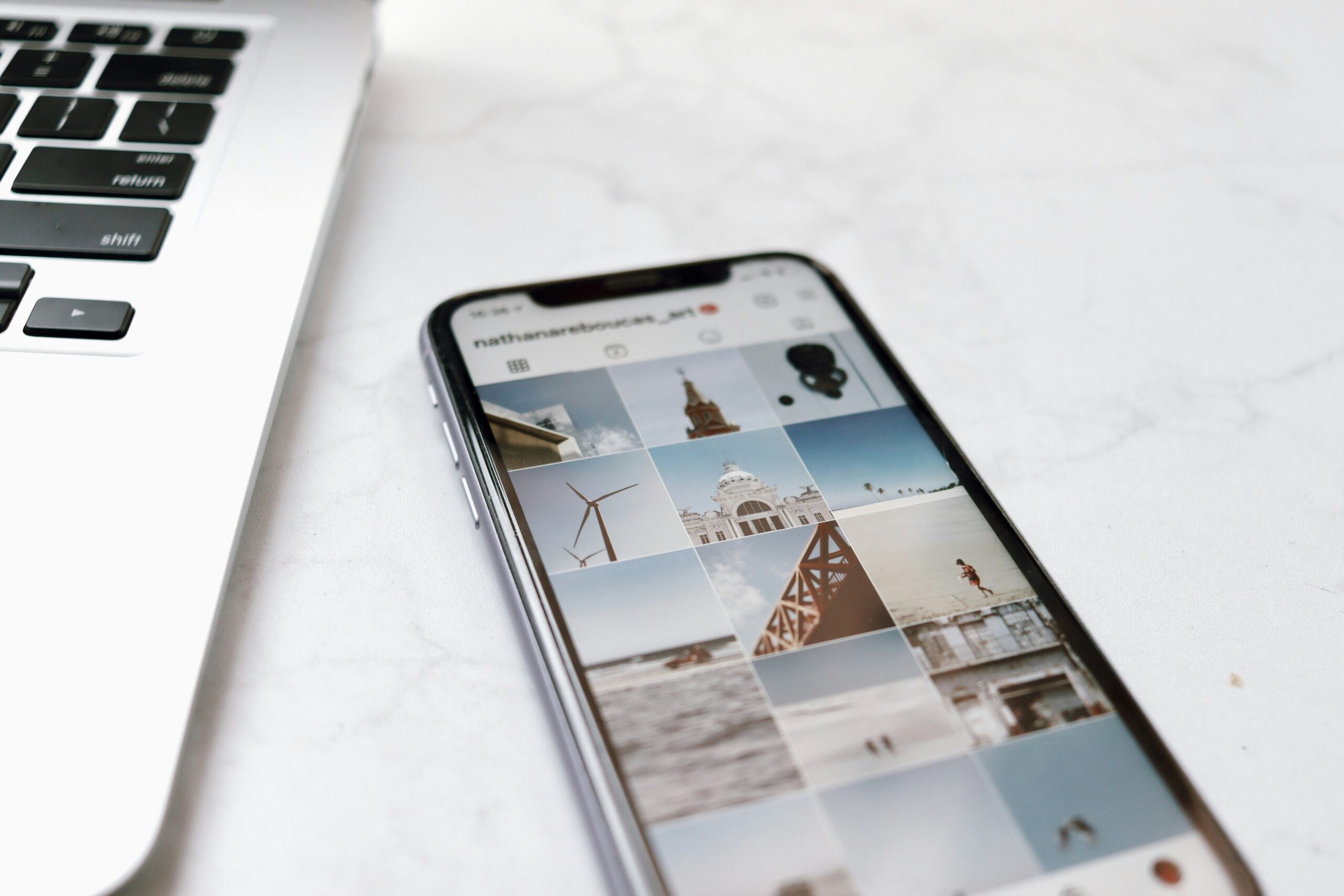
In the art world, a still life is an arrangement of inanimate everyday objects—be they from Nature such as flowers, a dead bird or insect, freshly caught fish, or manmade objects like bottles, drapery, pottery, etc. The term comes from the Dutch stilleven and the French nature morte. Most likely, elements of this art genre were around since the birth of art.
Certainly, images were present in early Egyptian and Greek art. In Western painting, the still life as a genre is said to have blossomed in 17th-century Holland. Anyone skimming over the history of Western still life paintings will encounter Caravaggio and Brueghel, the Impressionists Degas and Renoir, post impressionists Van Gogh and Cezanne, Picasso and Dali, and on and on to our present times.
The arrangement of colors and shapes marks the culture of a given era’s approach to still life—from hyper realistic, to surrealistic, to abstract. For some, still life carries symbolic or religious messages about mortality (memento mori), while for others it is simply color, shape and composition.
I still recall an oil painting by Emilio Alvero that graced my parents’ house in Pasay in the early, postwar years of my youth. It was a picnic setting with a basket of fruits, a plate of lobsters, oysters and a mud crab, along with bottles of drinks, all laid out on a beach against a seascape. From those postwar art student days onwards, my enthusiasm for still life continues to be stimulated by the works of the impressionists and post impressionists.
Let me tell you how I got into still life painting. Midway through my high school years, my father graciously granted me the privilege of taking private tutorial lessons in art. It was 1947. I was 15 years old. The teacher he chose was Dominador Castañeda, then a professor at the Department of Fine Arts of the University of the Philippines. Some years later, in 1955, he would be appointed director of the UP Department of Fine Arts.
Castañeda proved a most gracious and patient guru. Brimming with enthusiasm, he led me through the first steps in the craft of drawing with a charcoal pencil. The very first lesson in drawing he instructed me to tackle was a still life. It is a standard and practical first subject for any art student because one has full control of the lighting and the arrangement of the objects to be drawn or painted.
By means of these still life studies, Castañeda patiently guided me, every Saturday afternoon, through various mediums—pastel, watercolor, and finally, oil. For sentimental reasons, I still have those first oil paintings on wood panels. All those first ones— about a dozen—were still life.
As I slowly progressed, Castañeda then tutored me, over a period of three years, in the clothed human figure, finally culminating in portraiture. By then, the still life—or what Castañeda and his generation called bodegon (the Spanish term for still life)—had been imbedded in my aesthetic repertoire.
After graduating high school at Far Eastern University in 1950 (which also marked the end of my private tutoring under Castañeda), I traveled overseas and enrolled at University of Notre Dame in Indiana, United States. Once more, the still life was offered as an academic exercise by my art professors throughout those university years. But by then I had found my own direction. Four years later in 1954, I received my Bachelor of Fine Arts degree.

My first one-man show—which opened on March 19, 1960 at the Contemporary Arts Gallery run by Manuel Rodriguez Sr. at 1416 A. Mabini in Ermita—naturally featured various still life works in oil and watercolor. Out of 67 paintings hanging on the walls, 23 (about a third) were still lifes. To my delight, 11 of those still lifes were sold.
One still life from the show, “Daisies,” served as the cover of the April 24, 1960 issue of the Sunday Times Magazine. Photos of one of my paintings, titled “Still Life With a Philosophy,” along with another called “Flowers and Gold,” were splashed in the magazine’s inside pages.
Experimentalist
That first solo exhibit received favorable comments in that Sunday Times article: “His paintings reveal Roces as an experimentalist daring to work with new mediums on new material… They show a romantic, even poetic imagination.” An accompanying critique from Mario Mercado observed: “With his brushes and palette knife, Roces creates and destroys just to create more pleasing plastic images of his visual experiences. For instance, a finished painting of hibiscus flowers carefully done with brush and thin subdued oil colors may still undergo a complete change through an impasto of bold colors of red and yellow arrangement in pseudo cubistic manner in order to relax the tension of some colors and designs… Ding Roces’ images are generally focused on the positive side of life. His canvases are poetic with their flowers, fruits, moon and birds.” (Sunday Times Magazine, April 24, 1960). I was off and running.
In my second one-man show in 1963—this time at the National Library—critic Ante Radaic observed: “Probably the most noteworthy characteristic of Roces’ art is his use of strong and vibrant colors, applied with special intensity, in his interesting still-life creations. He is a sensitive colorist of clean and warm palette who delights in Nature that is discovered and clothes her with the warmest and most intense colors.” (“Artist Alfredo R. Roces—Restless And Sensitive” by Ante Radaic, Sunday Times Magazine, May 5, 1963)
My third one-man show at Solidaridad Gallery in 1968, elicited the following brief comment from Chronicle columnist Rosalinda Orosa: “Mr. Roces rarely hangs up his works for public view, but when he does, he can always be proud of them. He has too much integrity to do anything in slapdash manner, for which reason, his exhibits have come to be known for quality rather than quantity.” (The Saturday Chronicle, Dec. 7, 1968.)
A lot of water has flowed under the bridge since then. Fifty-nine years after that first one-man-show in 1960, to be exact. With this mini-retrospective I hope to share with the public that part of me that is revealed exclusively in one genre: still-life paintings.
Only one facet
I stress that this is only one facet of my art. Aside from the still-life genre, I paint the human figure and do portraiture and landscapes, and abstract expressions. I find myself forever experimenting with a variety of visual art mediums—from charcoal to pastel to watercolor, to oil, acrylic, and digital mediums, ceramic paint, sculpture, pottery, photography—in a wide range of expressions or “styles,” from hyper-realistic, to impressionistic, to abstract, to assemblage. I also indulge in sculpture, pottery and photography.
I bring this up because it seems that while my many-sided works in a variety of visual art mediums received favorable reviews in my early shows, exhibiting my multifaceted paintings simultaneously in solo exhibits had also left other viewers perplexed. Here is one columnist’s reaction to my one-man-show in 1968: “The variety of Mr. Roces’ style is endless and the harassed viewer, in search of the hidden key to his art, is likely to end up screaming, ‘Will the real Mr. Roces stand up, please?’” (Armando D. Manalo, Right of Reply, The Chronicle Magazine, Dec. 28, 1968.)
Applying different mediums to a wide-ranging variety of subjects creates and results in a variety of voices. Add to this the fact that I am a writer and editor as well, and you get a many-sided personality: an academically trained painter, a daily columnist for the Manila Times for 12 years (1960-72), a teacher in Humanities at FEU and member of the FEU Board of Trustees, editor in Sydney, Australia, of Geo Australasia’s Geographical Magazine for a dozen years (1978-90), and author of more than a dozen books, four of which have gained the Manila Art Critics’ National Book Awards.

Thanks to martial law under Marcos, I found myself pushed out and forced to settle down with my family in Australia for the past 42 years. I bring this up to explain the reason for my many-pronged eclectic approach to art, and my inclination toward multimedia.
An art medium has its own characteristic. For example, as writer, the medium of words lends itself to ideas, to the analysis of issues, along with a deep engagement in political, religious, philosophical and scientific discussion. Naturally then, the medium of words is where I channel my philosophical and protest expressions. This allows me the chance to use paint—particularly still life—for play.
Serious content
I have been blessed with the option to express serious content via words and to use paint for play. Of course I also use paint for profound or serious content, and use words for humor; but in general, painting to me is the best outlet for joy and play. On the other hand, my preference to write nonfiction rather than indulge in fanciful fiction allows me a great outlet for ideas, for analyzing political events, human foibles, for documenting history and culture, for expressing pain and rage.
A good half a century and many solo exhibits since that 1968 third one-man show, I have continued to pursue this art genre of the still life as one form of visual offering, or prayer, to the Creator. Now, for the first time, I present a solo exhibit exclusively on this one genre—the still life.
Something catches my eye—my wife Irene’s latest orchid blossom, a half-open guyabano, a dead bird—and quickly and excitedly, I grab my pastel set and sketching pad. My approach to still life painting is always straightforward. Direct and simple. No convoluted angst to suffer in the process, only the struggle to get the painting right.
The challenge of organizing space, color and composition in a still life never culminates in one final solution. Interpreting and reinterpreting a simple thing like a slice of papaya, dried fish on a plate, a glass of wine, or an orchid sparks an endless buzz in me, like hearing a familiar but elusive melody in my head. Pushing and probing the boundaries of the individual and unique characteristics of various mediums—pastel, watercolor, oil, acrylic, digital art and assemblage via a still life—challenges me with rows of prison-bar clichés that I must break away from. That is what keeps me painting.
While still life as a subject remains eternal, the vision and the interpretation, the mood and one’s psychological state of mind of the moment, never stay the same. Light is ever changing. The shape, color and texture; birth, growth, maturity and death in the cycle of Nature—these are ever present with every passing season. And when a still life painting is signed and completed and leaves my studio—hopefully to be seen by many varied eyes—the reaction, interpretation and vision of each viewer again imbues the image with the good, the bad, and the indifferent, for the input of the viewer is also part of the aesthetic experience and the continuing life of every painting.
Each still life completed has its own story. Allow me to cite just a random handful for a fleeting glimpse of the evolution of some of my still life paintings and how these came to life.
The very first still life I tackled in the medium of oil was my dear mother’s tiny cactus plant in a red pot. Professor Castañeda gave me a small but thick plywood board to paint on. I still treasure this 1947 first opus. Then about a decade later, when I had barely started to make a living as artist, my thoughtful father approached me for my first commissioned painting. He had been shopping around for a wedding present, he said, and he had a budget of P40. I produced a still life in oil of a pile of mangosteens and a scattering of mandarins on a plate. The year was 1958. More than 50 years later, in March 2016, that very same painting surfaced at the Salcedo Auctions where it went under the hammer for 3,663 euros. The curious fate of that painting tells me that time and circumstances are indeed unpredictable.
Pink shoes
In 1960, while rushing up the stairs to lecture to my class in Humanities inside the Arts Building at FEU, I glanced out at the sordid world so close outside and spied a window in a dilapidated shanty lined with rusty, corrugated, galvanized-iron sheets. Sitting on a window shelf—just a few meters from me—lay a pair of bright pink, silk-lined, high-heeled lady’s shoes. The bizarre contrasting image of a high society icon in such miserable squalor teased my senses. What were they doing there? Did those shoes belong by chance to some hardworking nightclub hostess?
When I got home I reconstructed it on canvas. I borrowed a pair of somewhat similar shoes as a model. “Pink Shoes” definitely said something about Filipino culture and our society of those times. But who would have imagined then, that more than two decades later, the First Lady Imelda Marcos would give ladies’ shoes that same symbol of extravagance and corruption, glamour and decadence?
Speaking of Ms Marcos, in 1968, the First Lady had graciously volunteered to be the guest of honor at my third one-man show held at Solidaridad Galleries. Mingling with the crowd, and chatting with two of my guests, H.R. Ocampo and Cesar Legaspi, she asked them which painting among those in the exhibit she should get. They recommended to her “Spice Island,” a hyper realistically painted still life arrangement of a piece of driftwood, an Ifugao wooden spoon, onion, ginger, red capsicum and other objects. By coincidence, this casein painting on white gesso board was featured, two months later, in the Weekly Women’s Magazine of Jan. 31,1969.
Today, given Ms Marcos’ subsequent promiscuous acquisition of world-famous paintings by superb, internationally acclaimed European masters like Monet, Pissarro and Sisley, that modest painting of mine would have to take the lowest place in her vast collection. Of course it is now lost forever, gathering dust like her thousands of abandoned shoes.
The artist controls the arrangement of objects in a still life. By deliberately juxtaposing divergent or similar objects, he provokes thought, irony, spirituality, at times even a smile from the viewer. One 1989, highly realistic pastel painting, in the collection of Eddie and Marilou Pineda, invites the viewer’s attention to the placement of a bottle containing a crucifixion scene. Scattered beside this religious icon are 10 green apples and a child’s glass marble. The title “Recollections of Paradise” is meant to invite contemplation.
With the passing of the years, my still life paintings traveled in another direction through the simple method of combining genre and medium. In an oil painting on canvas, I placed a still life against a landscape. This was while I was on a summer holiday on Fraser Island in 2002, where I was happily painting seascapes. I thought I would tackle a still life as well. As I began setting up the fruits on a bowl, I was struck by the entire scene around the still life: the terrace of the summer house, and the sea beyond. That’s how “By The Sea,” a still life within a landscape, came about.
Fast-forward a dozen years to 2014, when—on my iPad—I created in digital form a
hyper-realistic still life of an apple. I was mulling over the colored layer for the background, when—in a “eureka” moment—I hit on the idea of making the background a digital copy of “Window,” a landscape I had painted in Bungarby 10 years earlier. The result is a digital close-up painting of an apple married to an oil painting (in digital photographic form) of a window with a landscape view done in 2004.
The use of a different medium naturally creates a visually different image. For some decades now I have put together found objects (what most would call junk, manmade or natural ) into a composite whole in a medium known as assemblage. This mind game between what is real and what is within the context of a painting, between form, color and texture, is absorbing and excites my senses. Yes, my still life paintings delight in playing between nature and art object, between the accidental and the carefully contrived image; between the mundane discarded object and the serious artwork that is the focus of attention.
I chanced upon the fragment of a bark from the paperbark tree (Melaleuca) in my usual walk around the neighborhood. This became the object featured in a still life assemblage. The final result, “Homage to the tree-bark (Melaleuca),” marks a long evolutionary process since that first oil painting of a cactus plant 72 years earlier.
However, I have not ceased to work along very traditional still life painting modes. And here the spirit and expressive qualities of the traditional art medium—say pastel, oil or watercolor—are what I seek to bring out. Two slices of watermelon in the collection of Virgie Ramos gives off a different character from my latest 2019 pastel painting “Pegasus,” and from “Papaya,” a 2017 ceramic painting on a tile.
So here they are, assembled for one moment in time. One-hundred still-life paintings and sketches by yours truly over a span of 72 years. Starting with a 15-year-old’s earliest attempts while in his family house in Pasay in the late 1940s, to the most recent labors of this 86-year-old painter, continuously exploring art forms in the peace and quiet of his home in Sydney. May they give you as much pleasure and release as I had creating each and everyone.
This personal milestone exhibit would not have been possible without the expertise and very kind assistance of Vita Sarenas and Raquel Samaniego of Finale Art Gallery. I take this opportunity to also thank my departed art mentors Dominador Castañeda, of course, and George Grosz, under whom I took up an extra year of drawing the human figure at the Art Students’ League of New York in 1955. This mini-retrospective is dedicated to my father, Rafael F. Roces, my mother, Inocencia Reyes, and to my beloved wife Irene, for their boundless love and support. –CONTRIBUTED
The artist wrote this for the catalogue of his forthcoming exhibit. The Alfredo Roces’ retrospective of still life paintings from 1947 to 2019 will run at Finale Gallery on Feb. 15-March 15.













































